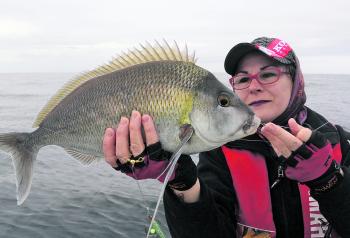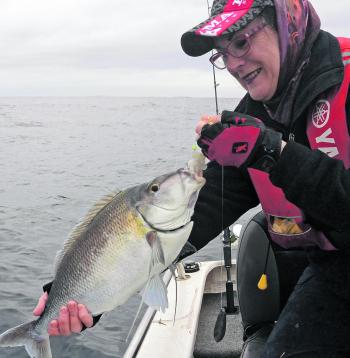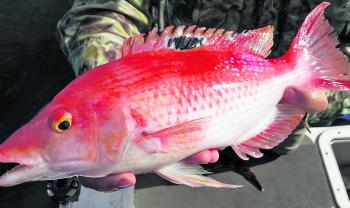Whether undertaken by paying passengers aboard chartered ‘party boats’, or from private vessels of all sizes and shapes, bottom fishing with bait remains an extremely popular and effective style of offshore angling. But even this traditional branch of the sport has benefitted from modern ‘finesse tackle’ breakthroughs over recent years.
Bottom bouncing, bottom bashing, plum bobbing… However you choose to describe it, dropping a couple of baited hooks to the sea bed with the aid of a fairly hefty sinker remains one of the most popular and productive ways of harvesting a fresh meal or two of seafood. From Tassie to the Torres Strait, you’ll find Aussie offshore anglers drifting or at anchor in boats of all shapes and sizes over reef, gravel or sandy sea floors, chasing everything from snapper, morwong, flathead and nannygai down south to emperor, coral trout, sweetlip and cod up north.
Traditionally, bottom bouncing in this country has been undertaken using relatively heavy tackle. Thick, monofilament handlines or short, stiff boat rods mated to big overheads and direct-drive centrepin reels were standard fare until recent times, and still are in some regions. However, switched-on deep-sea anglers are increasingly turning to more sophisticated modern tackle in order to increase the efficiency of their pursuit, and raise the fun factor associated with bottom fishing.
In particular, the adoption of thin-for-strength braided and fused gel-spun polyethylene (GSP) fishing lines has allowed offshore bait fishers to dramatically reduce both the overall bulk of their outfits and also the weight of their sinkers. These skinny, low-stretch “super lines” make it possible to effectively present baits on the bottom in 50, 100 and even 150 metres of water while using much smaller sinkers than in the past. Just as importantly, GSP main lines allow an angler to clearly feel the sometimes tentative tugs of a biting fish across that considerable distance, and to more easily set the hook with a sharp, upward sweep of the rod tip.
It’s not just lines that have changed, either. Modern bait hooks are considerably sharper and thinner for their strength than those of old, while modified patterns such as the unusual-looking circle hooks mean that far less fish come unstuck from anglers’ rigs during the long haul back to the surface.
Rods and reels have evolved, too. Today, most bottom bashers prefer lighter overhead or spin outfits built around 1.5-2m graphite or composite rods. Because their GSP lines are so much thinner, these anglers no longer need over-sized reels. A 6000 to 10,000 size threadline or a 10-20 size overhead will easily do the job. Of course, a few really dedicated deepwater specialists will take things one step further and opt for an electric-powered reel, but unless you regularly fish in waters deeper than 150m, these expensive tools are far from essential.
Terminal rigs and baits are probably the aspects of bottom bouncing that have changed least, beyond the general reduction in sinker weight already mentioned. Most anglers still use somewhere between two and four hooks (check you local regulations to find out how many you’re allowed). These hooks (typically 3/0 to 7/0 in size) are attached to relatively short droppers as part of a Paternoster rig, with the sinker hanging at the bottom end. Streamlined bomb or snapper-lead style sinkers are best as they descend fast, without tumbling or spinning. Hook droppers may be created using knots such as the Blood Bite Dropper, or attached to three-way swivels. Keeping the droppers short (well under 30 cm in length) greatly reduces their propensity for twisting and wrapping around the rig as it plummets through the water.
Exactly what strength of GSP main line and mono leader you choose and precisely how you construct your Paternoster rig will vary depending on the terrain you’re fishing and the species list you wish to target, as will the baits you load those hooks with (popular choices include prawns, squid, octopus, pilchards and cut fish flesh). These minor variations aside, the basics of bottom bouncing remain the same… as does its deadly effectiveness as a technique.
Reads: 8003
Things can become a little hectic at times when bottom fishing aboard a crowded charter boat! Tangles happen.

Wrapping heavy sinkers in tape or rubber tubing reduces damage to boats and tackle and is very common on some charter operations. The catch this time is a spangled emperor.

Jo starling with a very nice rubberlip or grey morwong taken while bottom bouncing with prawn baits. Note the three-way swivel: a viable alternative to tying dropper loops.

With a slow drift, Jo was able to get away with using a relatively light sinker on her bottom-bouncing rig, even in 50m of water.

The black-spot pigfish is a reasonably common bottom fishing catch in southern waters, and provides a tasty meal.




